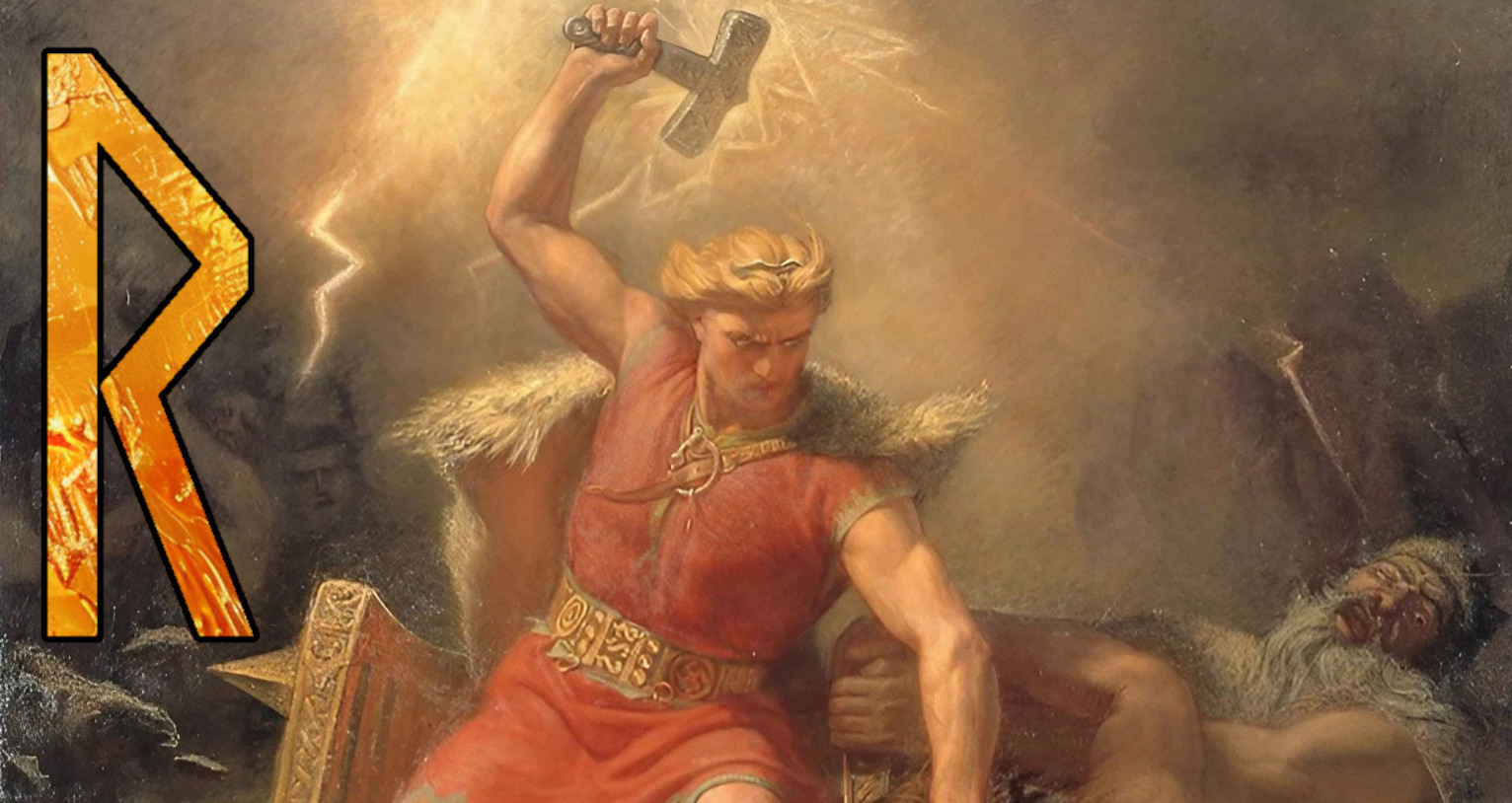ᚱ – Raidho, meaning “ride” or “journey”, is the reconstructed Proto-Germanic name of the r-rune, with the IPA sound value of [r]. It is the fifth rune of the Elder Futhark and the fourth rune of the Uthark.
In addition to its association with riding and travelling, Raidho also means “wagon” and is therefore sometimes called the “wagon rune”. It is the rune of the god Thor.
This article is part of our exclusive series on the origins and secrets of the Nordic runes in the Elder Futhark and the merits of the intriguing Uthark theory proposed by the Swedish philologist Sigurd Agrell, professor at Lund University, Sweden.
The Uthark is a secret cipher, based on positioning the Fehu rune at the end of the rune row, like an ace in a deck of cards, revealing esoteric philosophy reaching deep into the heart of Norse culture and religious beliefs.
Meaning and interpretation
Like a chariot supported by four wheels and a horse or goat supported by four legs, Raidho is associated with the number four.
Four is also the number of the natural cosmic order in Norse mythology. The world itself, for example, is supported by the four cardinal dwarfs Nordre, Södre, Östre and Västre (North, South, East and West). Four stags are also chewing on the buds of the world tree which can be viewed as destructive cardinal forces making nature move in a cycle.
The number four recurs as a metaphor for nature and its cyclical rhythm – as reflected in the four seasons. The rune is therefore also seen as a protective rune of agriculture.
The natural and cosmic order is upheld by the god Thor, who rides in his wagon with his hammer Mjölnir (Mjolnir, with the meaning of “crusher” or “grinder”) to fight the forces of chaos. Like the Raidho rune in the Uthark, Thor is also associated with the number four, for example by naming the fourth day of the week – Thursday. In modern Swedish the name of the day is Torsdag, literally “Thor’s day”. Contrary to popular belief Thor however is not the god of war, Tiwaz the older and less known god is the god of war. Friday is also named by the Goddess Frigg.

Symbolism and magical use
Symbolically the rune is also represented by the sun cross and the swastika, which illustrate the wheel of Thor’s wagon and the journey of the sun in the sky, banishing the forces of darkness.
The numerology of four has been found inscripted on runestones in connection to Thor. “Odin’s troll songs” in Hávamál, which consists of no less than 18 stanzas, tells about Thor in the fourth stanza. The number of four is also mentioned in the troll songs as “possessing the power to break shackles”.
On the Glavendrup Stone on the island of Fyn in Denmark, dated to the early 9th century, the longest runic inscription found in Denmark has been preserved. In the inscription, Thor’s blessing is invoked in the final four stanzas, with four words each, to curse those who desecrate the stone.
Þor wigi þæssi runaʀ
At ræta sa wærþi
æs sten þænsi ælti
æþa æft annan dragi
Free translation:
Thor hallow these runes
cursed will be the one who
destroys this stone
or carves runes in it to the glory of another

Divination
As the rune of Thor, Raidho advices one to be like Thor – to use force and responsibility to gain control of life or a certain situation. It also advices one to do the right thing – even if one meets resistance.
The basics of rune divination
According to Norse belief, the runes represent aspects of the web of destiny, called the web of Urd (Wyrd). This web is intimately connected to time and the three Norns; Urd, Verdandi and Skuld. The Norns are weaving the threads of the web and represent what was, what is and what is to come.
The Roman historian Tacitus, among others, noted that rune divination was a widespread practice among the Norse. One of the most basic forms of such divination is to pray and draw three runes on twigs or cards which will signify the three Norns. By reading the web of Urd one may understand the present of Verdandi as well as the past, and also lift the veil of Skuld and see what lies hidden in the future.
The rune denotes a journey, earthly or spiritual, where ones purpose is clear and has a certain goal in sight. The message of Raidho is that those who wish to be initiated into magical wisdom must make sacrifices and gain new experiences through transitions. One form of transition is to isolate oneself for a few hours or days to travel and make discoveries within oneself, as Jesus went into the wilderness to seek insight, and Nordic shamans went into the forest for the same purpose.
Facing up, Raidho indicates a pleasant and rewarding journey ahead. If it drawn upside down, it tells about a journey caused by negative events, that may become necessary.
Discover the following rune Kenaz – the rune of fire
The Nordic Times


















